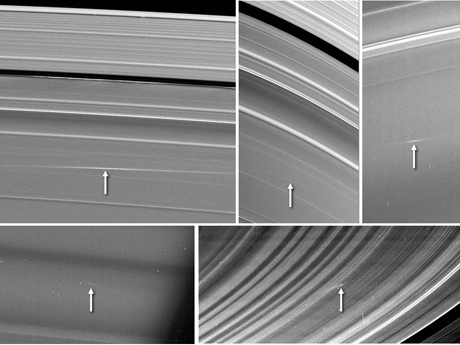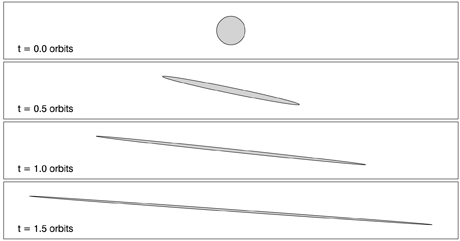Small meteors punch through Saturn's rings
By Susan Kelley

Scientists have been searching for years to find proof of small meteors that they believe have been smashing into Saturn’s rings. Cornell researchers and their colleagues announced today that they now have evidence of these collisions, thanks to images of Saturn’s rings taken by NASA’s Cassini spacecraft.
The April 25 paper published in the journal Science provides the first direct evidence of small meteoroids, around a half-inch to several yards in size, breaking into streams of rubble and crashing into Saturn’s rings. The scientists, led by Matt Tiscareno, senior research associate at Cornell, were able to see the tracks left by nine of these objects in 2005, 2009 and 2012. The Saturnian equinox in summer 2009 was an especially fruitful time to see the debris left by impacts: The shallow sun angle on the rings caused the clouds of debris to look bright against the darkened rings in Cassini’s pictures.
“We knew that these little impacts were constantly occurring, but we didn’t know how big or how frequent they might be, and we didn’t necessarily expect them to take the form of spectacular shearing clouds,” said Tiscareno. “The sunlight shining edge-on to the rings at Saturnian equinox acted like an anti-cloaking device, so that these usually invisible features became plain to see.”

This latest Cassini finding makes Saturn’s rings the only other location besides the Earth, the moon and Jupiter where scientists and amateur astronomers have been able to observe impacts in process. And the results suggest that small particles are hitting Saturn and the Earth at about the same rate – even though the planets are in “two very different neighborhoods in our solar system,” said Linda Spilker, Cassini project scientist at NASA’s Jet Propulsion Laboratory. “It took Saturn’s rings acting like a giant meteoroid detector – 100 times the surface area of the Earth – and Cassini’s long-term tour of the Saturn system to address this question.”
Results from Cassini have already shown that Saturn’s rings act as very effective detectors of many kinds of surrounding phenomena. For example, a subtle but extensive corrugation that ripples 12,000 miles across the innermost rings tells of a large meteoroid impact in 1983.
Tiscareno and his colleagues now think meteoroids of this size probably break up on a first encounter with the rings, creating smaller, slower pieces that then enter into orbit around Saturn. Because the tiny particles forming these clouds have a range of orbital speeds around Saturn, the clouds they form are soon pulled into diagonal, extended streaks.

Studying the impact rate of meteoroids from outside the Saturn system helps scientists understand how different planet systems in the solar system formed. Ring particles at Jupiter, Uranus and Neptune, for example, are very dark because an incessant hail of meteoroids has added carbon- and silicate-rich material. “But Saturn’s rings are unusually bright and clean, leading some to suggest that the rings are actually much younger than Saturn,” said Jeff Cuzzi, a paper co-author at NASA’s Ames Research Center. “To assess this dramatic claim, we must know more about the incoming mass flux. This latest analysis helps fill in that story with detection of impactors of a size that we weren’t previously able to detect directly.”
Other Cornell co-authors were Matthew Hedman, senior research associate; Joseph Burns, the Irving Porter Church Professor of Engineering and professor of astronomy; and Michael Evans, research associate.
The Cassini-Huygens mission is a cooperative project of NASA, the European Space Agency and the Italian Space Agency.
Media Contact
Get Cornell news delivered right to your inbox.
Subscribe